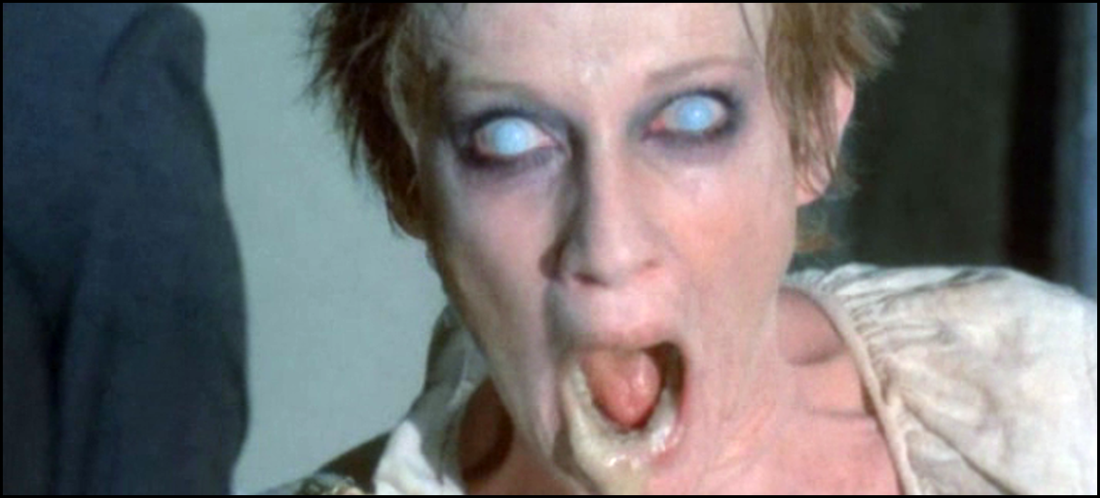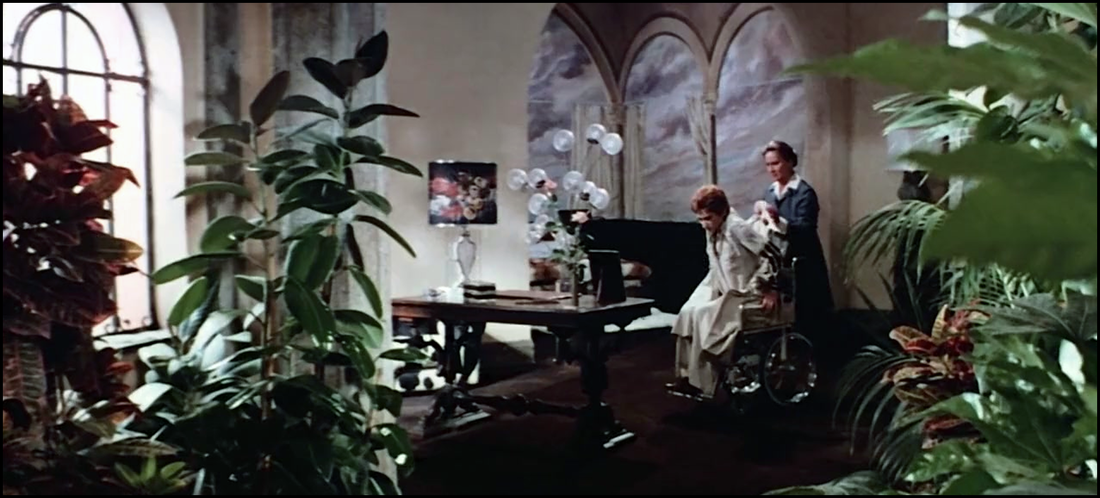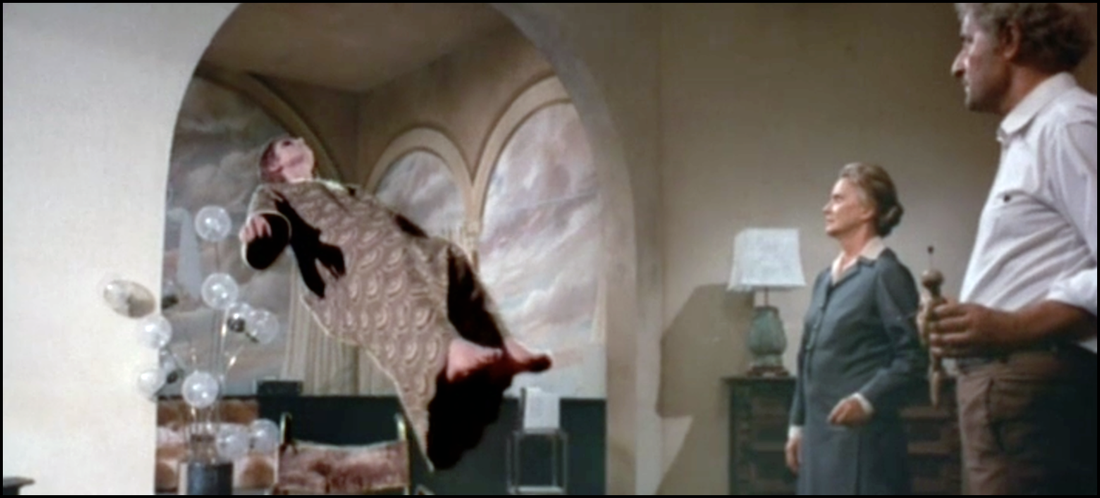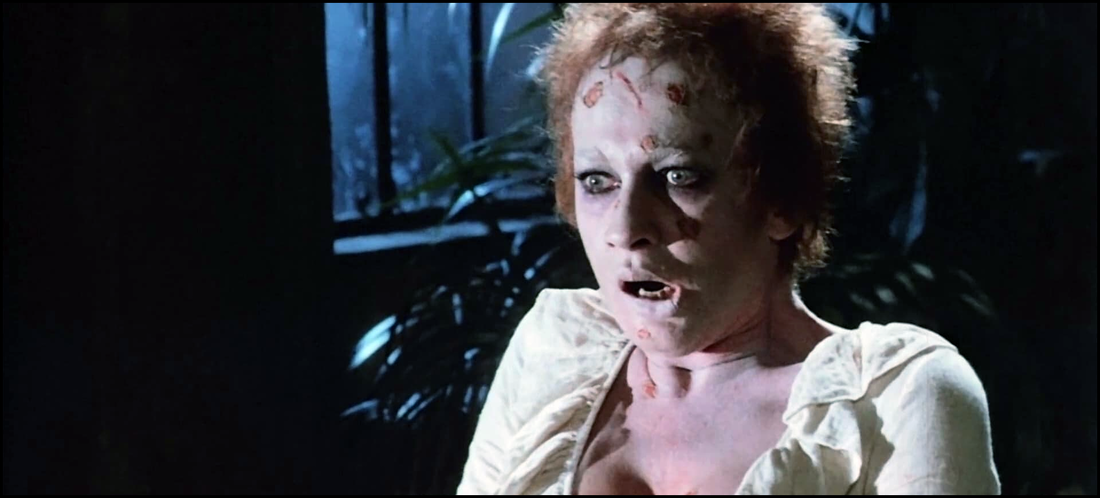Seriously, I knew nothing about it, nor would I likely have wanted to see something that terrifying on the silver screen. (C’mon, man! I was only eight!) I’ve since seen it twice; while I can appreciate the impact it had back then on the world-at-large, it’s a film that just doesn’t quite resonate with me the way others do. This is likely because I suffered through a plethora of (inferior) rip-offs that followed over the next several years – I was only just discovering a greater desire for Science Fiction, Fantasy, and Horror in my entertainment diet – so the idea of demonic possession was probably a bit tame by that time. Typically, this is what happens when you’re not fortunate enough to experience a trend at its inception.
According to theatrical release information on IMDB.com (yes, I know it can be hit-or-miss), Alberto De Martino’s The Antichrist didn’t screen in the U.S. until 1978, so I likely wouldn’t even have gone to see it then. Honestly, it probably would’ve appeared a bit too artsy for my young tastes, stuck in the throws of a lingering Star Wars frenzy that I was. But I’ve had the good fortune of seeing it now – all in its 4K restored glory – and though I don’t find it all that ‘possessing’ I would argue that this nifty Satanic chiller found at least one creative way to spin heads.
That’s gotta count for something.
From the product packaging:
“In Rome, a beautiful young woman is left paralyzed by the trauma of a horrific childhood accident. But when placed under hypnosis, she is seized by visions of her past life as a heretic and becomes a foul-mouthed seductress with a taste for perversion that leads to her defilement by Satan himself. Now, mankind’s only hope for salvation is a harrowing exorcism that will either cast out the Devil forever or open the door for the unspeakable birth of the Antichrist!”
Science Fiction, Fantasy, and Horror have always tied in very near and dear with all of my hobbies; and one time I actually tried to engage some members of a Facebook group dedicated to all things paranormal. Specifically, I wanted to know their thoughts on the subject of demonic possession as I had just finished a non-fiction book that only loosely touched on a few ‘true life’ tales. To my surprise, I was roundly taken to task as anyone and everyone who came into the post assured me that there was no such thing; that our culture was horrifically out-of-step with mental illness; and that I’d be better off leaving such books to lesser souls.
Ouch.
Since that experience, I have looked at films tied to the subject matter as a bit more escapist fare than anything else; and – no doubt a work of fiction – The Antichrist definitely feels more concocted than it does traced back to any news accounts of spirit possession. In fact, the script attributed to the director and screenwriting partners Gianfranco Clerici and Vincenzo Mannino plays out a bit too formulaic for my tastes. (Audience meets girl. Girl has several problems. Girl succumbs to the Devil’s flirtations. Girl pukes green. Etc.) Though there’s an interesting side story that explores past life regression hypnosis, the remaining examination of a life lived under Satan’s manipulative power moves predictably from Point A to Point B to … well, I think you get the point.
Even the film’s big sequence – the reason anyone comes to watch films of this type – unspools with a tennis match’s cadence: the exorcism is little more than a patient back-and-forth between the forces of good and evil. The priest scores first, the Devil volleys, now the Devil scores, and the Priest serves for the match point, and so on. Each player deliberately ups the ante with the successive tete de tetes, and it becomes clear that this will continue until the desired outcome is achieved.
Believing she’s been spurned by both her father (he’s taken a new mistress against his daughter’s wishes) and the Holiest of Fathers (no miracle treatment), Ippolita’s conversion to evil – while a bit slow – is entirely believable within the context of her story as presented. Further awakened to a devious family history through hypnosis, she’s understandably smitten with finding a newfound strength through evil. Her impulses finally lead her to seducing and murdering a travelling young man , convincing the audience that she’s well on her way to becoming a force that needs to be reckoned with … before it’s too really late.
And her duplicity doesn’t stop there. As the story wears on, she attempts to get her ravenous hooks into any man in her life, from dear old dad down to the always-at-her-side brother. (Whether or not the siblings act upon her machinations is left a bit unclear, though I’m inclined to think they did the deed. Why else introduce it?) As you might expect, Ippolita even offers to mount any priest who darkens her door, tempting them with the flash of her open thighs. I’m guessing they weren’t exactly won over by her thinning hairline, her boil-covered face, and her vomit-stained lips.
Aesthetically, there’s a lushness to several of the shooting and/or set locations. For example, the Oderisi mansion has rooms with impressively high ceilings. Its walls are decked from floor-to-ceiling with expensive paintings. Its hallways are lined with statutes bearing somewhat grotesque expressions. Ippolita’s bedroom is adorned with some particularly lavish décor, situating her regal-looking bed beneath a colorful mural of a clouded sky. (Fresco style? Apologies, folks, but I’m not up on artistic techniques.) While such deliberate extravagance helps to lift the story from the mundane, this motif happens so consistently I’ve no doubt that these were creative choices made by the storytellers and not organic to this world, its characters, etc. Are we to believe such excess leads to possession? Well, it’s never quite clear, but the folks partaking of the film’s notorious Satanic ritual – complete with goat – might feel differently.
Sadly, the rest of The Antichrist’s visuals are all well dated by today’s standards. The effects sequences especially – those of furniture flying about the room or murals coming off the walls – are obvious effects trickery, much of which were superimposed in post well after the live shoot. While some of the orchestrated chaos looks effective, all of this is the kind of stuff found at any major theme park attraction these days. Consequently, the frights are more ‘charming-scary’ than they are ‘scary-scary.’ Though I’ve no problem with it for the purposes of critiquing the action, I suspect it might be hard for a film like this to find anything more than a cult audience today.
- Raising Hell – featurette with Director and Co-writer Alberto De Martino and Composer Ennio Morricone
- Audio Commentary by Author and Film Historian Lee Gambin and Film Critic Sally Christie
- TV spot
- The Tempter (alternate film title) Opening Credits
- And English or Italian 2.0 Audio tracks
Mildly recommended. The biggest drawback I had with The Antichrist is that it feels a bit derivative at times; and my research indicates that the film did pull more than a bit of inspiration from William Friedkin’s The Exorcist released the previous year. (Hello, green vomit!) Still, director De Martino’s picture makes good use of some interesting production detail, some interesting exteriors, and a creative yet spitting performance from the fetching Gravina. I suspect there’s a trimmer cut of the film out there somewhere that might play a bit better on pace as well … but you gotta give the Devil his due.
In the interests of fairness, I’m pleased to disclose that the fine folks at Kino Lorber provided me with a complimentary Blu-ray of The Antichrist (1974) by request for the expressed purposes of completing this review; and their contribution to me in no way, shape, or form influenced my opinion of it.
-- EZ





 RSS Feed
RSS Feed